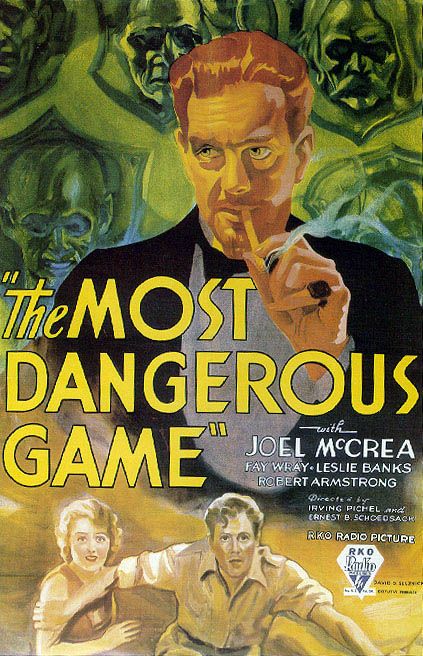 I must admit: the first time I watched The Most Dangerous Game (1932) I wasn't all that thrilled with it. On watching it a second time, however, I found that I like it a lot more. I'm not entirely sure why -- perhaps because I'm more accustomed to the film-making techniques of the era, having seen so many movies of the same time period since the first go-around. It does have its fair share of flaws, but on the whole this is a fairly good picture.
I must admit: the first time I watched The Most Dangerous Game (1932) I wasn't all that thrilled with it. On watching it a second time, however, I found that I like it a lot more. I'm not entirely sure why -- perhaps because I'm more accustomed to the film-making techniques of the era, having seen so many movies of the same time period since the first go-around. It does have its fair share of flaws, but on the whole this is a fairly good picture.The film begins with renowned hunter Bob Rainsford (Joel McCrea) aboard a yacht with a few of his pals, amicably discussing the merits of hunting for sport over glasses of scotch. Their conversation is interrupted when the ship, led astray by misplaced signal buoys, crashes into a reef off the coast of a Mysterious Island. With the rest of the crew drowned or eaten by sharks, Bob is left to swim ashore by himself. On the Mysterious Island he stumbles upon a Mysterious Castle, inhabited by an eccentric Russian Count named Zaroff (Leslie Banks) who shares Bob's passion for hunting and explains that he came to the island in order to hunt "the most dangerous game." Zaroff introduces Bob to a pair of fellow castaways, a sister named Eve (Fay Wray) and a brother named Martin (Robert Armstrong). After a little polite socializing, Zaroff sends Eve and Bob to bed, but offers to show Martin -- who is by now quite drunk on vodka -- his trophy room.
When neither Zaroff nor Martin return, Eve begins to worry and asks Bob to sneak into the trophy room with her. There they are mortified to discover that Zaroff's trophy collection consists primarily of severed human heads. Shortly after this revelation, Zaroff returns with Martin's body -- his newest trophy. When Bob confronts Zaroff, the Count offers him a choice: either hunt alongside the Count or become his next prey. Being a fine and upstanding gentleman, Bob refuses the offer and is consequently set loose in the jungle with nothing other than a knife and his wits (Eve has opted to come along with him, understandably preferring Bob's company to that of Zaroff, who has quite clearly explained his plans to give her the old in-out after killing Bob). If Bob can survive for twenty-four hours, he and Eve will allowed to escape the island.
The central premise of the film is an intriguing one, and for the most part it is executed quite well. The film moves along at a healthy pace and never drags -- indeed, at only just over an hour in running time, it's a fairly short and sweet affair. The camera work is solid, with a few particularly interesting shots -- most noticeably a few first-person perspective shots of running through the jungle during the hunt.
The acting is competent, if a bit hammy in parts. Joel McCrea is good enough as Bob Rainsford, but Leslie Banks cuts it a bit too thick as the count (not that it really detracts anything from the picture). Although she does overplay the "swooning damsel" aspect of her character, Fay Wray is otherwise agreeable in her performance, showing off her particular flair for looking positively scared shitless (it should also be noted that she looks quite fetching with her hair its natural dark color). Finally, Robert Armstrong's appearance as the obnoxious, drunken Martin is brief but memorable.
What I noticed in watching the picture a second time is that in many ways, The Most Dangerous Game feels like a spiritual predecessor to King Kong. There are a few reasons for this. To begin with, both pictures were produced and directed by the team of Merian C. Cooper and Ernest B. Schoedsack. Both pictures featured Robert Armstrong and Fay Wray, the latter spending a healthy portion of both movies running around the jungle in a dirty dress. Even the jungle itself feels similar in both films, right down to the log suspended over a gaping chasm (I'm not certain if that was that meant to be so Freudian, especially given the implicit threat to Fay Wray's chastity that is present in both films. Then again, sometimes a log over a chasm is just a log over a chasm). Finally, the same campy spirit that makes King Kong so great is present in The Most Dangerous Game, even if it isn't on the same grandiose scale. As with King Kong, it's very much because of the picture's camp that I wound up enjoying it.
The film's reliance on the tried-and-true cliches of the adventure genre has a way of winning one over. It's not a picture that's going to have you on the edge of your seat, but The Most Dangerous Game is fun enough to merit at least one viewing (and hey, as luck would have it, the movie is now public domain, which means you can watch it in its entirety at the Internet Archive).
I am surprised to see first person shots being used so early in cinema history. But then again watching Eisenstein films you see a lot of techniques that are still being used and often not as well. I will have to check this one out when I get the time.
ReplyDelete